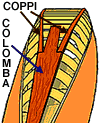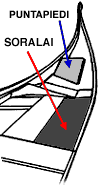
| The Gondola and its history |
| Using the Gondola |
| Bibliography |
| Press release |
| Itineraries |
| News |
| Links |
| Contact us |
| Postcards from Venice |
| Guest Book |
Capitolo 1 The gondola building
5 - The bending
pag. 1 2 3 4 5
| It has come the moment to turn the boat upside down to give it a right bending at " crescent moon". Even this result is got dipping the hull and drying it by the same fire of reeds, while some supports fitted by force between the beams of the ceiling of the squero and the 2 endings of the gondola, will give it a bending proportionate to the gondolier's weight to whom it is destined, so that for this weight, we cannot have a draught superior to the fixed one. | ||
 | Then the 2 terminals of the board are joined, of larch, that constitutes the central part of the bottom of the gondola, called "colomba di poppa e colomba di prua". Then, on the corners between the "piane" and the "sanconi", are set the 2 "coppi", long bands of larch to which they will be linked the "nomboli" that is the tables of draught in fir wood that, with the above mentioned circles, constitute the total cover of the sides of the hull. | |
| To finish they are put in order the side parts of the bottom ( called "sandoli") and it is closed, with the third "colomba" , the central part. They are also prepared the hemp "stoppe", that are inserted by force in the connections between the various boards to prevent every water filtration. Made this, the gondola is newly straightened and one provides with corrections of plane and glass-paper, to finish it outside and inside, making it completely smooth and polished. As defence from the blows against other boats and from skimming of the sides on the shores, the hull is protected in all its length from 2 elm fenders, called "masse". | ||
 | At last one provides to give greater comfort of rowing to the gondolier preparing a footboard at the stern, called "soralai", formed by a "puntapiedi" "reggispinta", usable in the 2 possibilities of one- or two-oars rowing. Till the last years of the nineteenth century the hull was not painted but tarred by Calafati. Then oils and paints began to be used, cleverly manipulated, and the squerarolo did not give up to add something of his own, handing down to his sons his secret. | |
